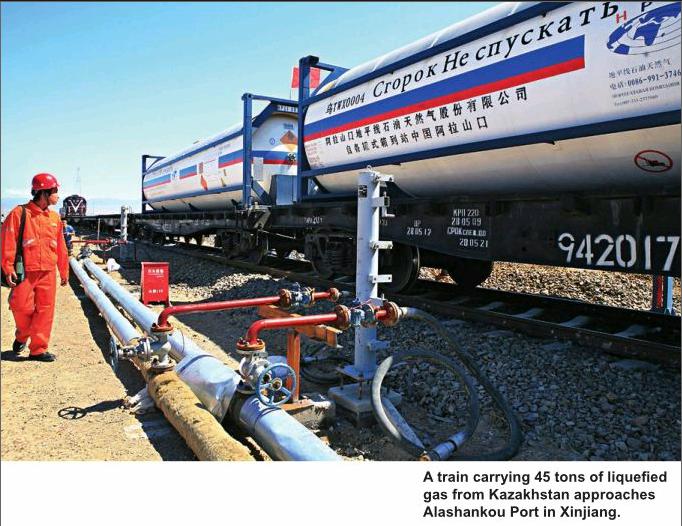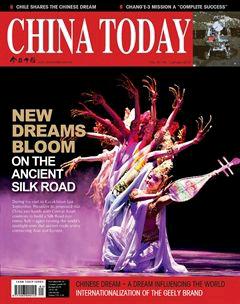China and Central Asia:Bright Prospects for Economic Cooperation
By+staff+reporter+LU+RUCAI



IN 138 BC, the royal court of the Western Han Dynasty sent Zhang Qian on a mission to the Western Regions, thus assigning the ancient Silk Road for trade and business exchanges between China and Central Asia, West Asia, as well as Europe and Africa. Since that time, this route saw Chinas papermaking technology, compass, gunpowder, printing techniques, silk, tea and porcelain spread to the world, while spices and gems came into China.
Central Asian countries, which the Silk Road traverses, have a long history of economic and trade exchange with China. In recent years, bilateral trade volume has witnessed a sharp increase, reaching US $45.94 billion in 2012. In September 2013, Chinese President Xi Jinping unveiled Chinas vision of building a Silk Road economic belt together with Central Asian countries, so committing to enhance further trade and economic exchange between the two sides.
Starting from Scratch
After the collapse of the Soviet Union, in January 1992 China sent a diplomatic delegation headed by Minister of Foreign Economic Relations and Trade Li Lanqing and Vice-Minister of Foreign Affairs Tian Zengpei to visit the five Central Asian countries – Uzbekistan, Kazakhstan, Tajikistan, Kyrgyzstan, and Turkmenistan. From January 2 to 7, at almost the rate of one country each day, China initiated diplomatic relations with the five countries.
In 1992, trade volume between China and the five Central Asian countries totaled US $460 million, accounting for 0.27 percent of Chinas total foreign trade. In 1995, this figure almost doubled to US $847 million. However, its proportion in Chinas overall foreign trade decreased.
In that period, Chinas major commodities exported to Central Asian countries were everyday consumer goods including textiles, clothing and food, as well as food materials. The major imports from Central Asian countries to China were chemical fertilizer, steel, cotton, nonferrous metals, and industrial chemicals.
Back then China was also not overly active in its investment in Central Asia. In 1995, Chinas registered joint-venture enterprises amounted to around 300 in Kazakhstan, 130 in Kyrgyzstan, and 80 in Uzbekistan. Most were lower-end industries like restaurants, trade, daily necessities, and food processing.
In 2001, the Shanghai Cooperation Organization (SCO) was founded. Its aim was joint work in combating terrorism, safeguarding regional security and stability, and promoting regional cooperation in such fields as economy and trade, environmental protection, culture, science and technology, education, energy, transportation and finance. The organization also set out to enhance comprehensive and balanced regional development in terms of the economy, society and culture.
Benefiting from the framework of the SCO, trade and economic exchanges between China and Central Asian countries have rapidly developed. China mainly imports energy and raw materials from Central Asian countries, and exports to them textiles, clothing, light industrial products and high-tech products. Today, China is Uzbekistan and Kyrgyzstans largest investor and second largest trade partner, and Kazakhstan and Turkmenistans biggest trade partner.
Deepening Diversified Economic Cooperation
The 2013 Report on the Development of Central Asian Countries, released by the Chinese Academy of Social Sciences(CASS), said that China and Central Asian countries were expanding cooperation in such fields as trade, finance and investment, and that similar cooperation in such non-resource sectors as agriculture, manufacturing, high tech and renewable energy industries is taking off.
Bilateral energy cooperation has been the highlight. Since its official operation in 2006, the China-Kazakhstan oil pipeline, with a total length of over 1,200 km, has delivered over 50 million tons of crude oil to China. A 10,000-km-long China-Central Asia natural gas pipeline, starting from the border between Turkmenistan and Uzbekistan in the west, across central Uzbekistan and southern Kazakhstan, since its inception in 2009, has transferred over 50 billion cubic meters of gas to China. Turkmenistan is thus the largest gas supplier to China –accounting for 51 percent of Chinas gas imports.
“Chinas energy cooperation with Central Asian countries is strategically important,” Xing Guangcheng, director of the Research Center for Chinese Borderland History and Geography, under CASS, said. He added that the ChinaCentral Asia gas pipeline benefits several countries, not only China as the import- er, but also Kazakhstan and Uzbekistan where the pipeline crosses. Both countries gain income from fees for allowing the pipeline to transverse their land.
During Xi Jinpings visit to Turkmenistan, the two sides reached agreement on speeding up construction of Line C of the China-Central Asia gas pipeline, while initiating construction as soon as possible to ensure Line D could be completed by 2016. It is predicted that by 2020, yearly natural gas exports to China from Turkmenistan will surpass 65 billion cubic meters.
In its mid-term development strategy plan, the SCO in 2012 proposed to strengthen member countries cooperation in finance, energy and interconnectivity, setting up financing guarantee mechanisms and tapping member statestransit shipment capacities.
China is now actively advancing cooperation with Central Asian countries on railways, highways, aviation, telecommunications, power grids and energy pipelines, to improve interconnectivity. Meanwhile, China is also expanding cooperation with Central Asian countries in such fields as logistics, peoples mobility, cash flow, and information flow. At the 2012 SCO summit, China committed to providing US $10 billion in loans to Central Asian countries, to be used for infrastructure construction like railways, highways, optical cables, as well as oil and natural gas pipelines. Meanwhile, many Chinese companies have become contractors for infrastructure projects such as highways, telecommunications and power facilities in Central Asian countries.
In ancient times, the main means of transport on the Silk Road were camels and horses. Nowadays, highways, railways, oil and gas pipelines, as well as air routes, form a diversified multidimensional modern Silk Road, Wu Hongwei, director of the Central Asian Studies Section, under CASS Institute of Russian, East European and Central Asian Studies, observed.
Bilateral cooperation in the financial sector is greatly anticipated by Central Asian countries. Chinas overall investment in Kazakhstan is over US $20 billion, and credit financing in various forms also exceeds US $30 billion. In 2012, China provided a total of RMB 560 million to Central Asian countries as non-reimbursable assistance.
Chen Yurong, director of the Central Asian Studies Section under the China Institute of International Studies, indicates that China and Central Asian countries should implement currency swaps and local currency settlements in current accounts and capital accounts as soon as possible. This will avoid exchangerate risks and lower circulation costs by reducing intermediate links. Removal of financial barriers will greatly facilitate trade and investment. On September 26, 2013, a forum in Xian focused on accelerating the establishment of a special SCO development bank to spur new vitality and a long-term driving force toward pragmatic regional cooperation.
A Promising Future
The dream of revitalizing the Silk Road has never dimmed for the countries along it.
In November 2007, the sixth ministerial meeting of the Central Asian Regional Economic Cooperation held in Duschanbe, Tajikistan, passed a US $18 billion strategic plan. The plan aims to build up a modern Silk Road of importance similar to its ancient role, turning Central Asia into a trade hub connecting Europe and Asia by improving its transport network of highways, railways, air transport and sea freight.
The proposal to develop a Silk Road economic belt is not a fantasy, Wu Hongwei said. Yin Songling, Chinas second ambassador to Turkmenistan, in March 2013 was invited to participate in the symposium in Turkmenistan themed“Great Silk Road Diplomacy: From History to the Future.” “Turkmenistan also intends to revitalize the Silk Road,” Yin said. This move echoes Xi Jinpings proposal to construct a Silk Road economic belt. “Revitalizing the Silk Road has been a dream cherished by Central Asian countries for many years. Since their independence, these countries have all hoped to give full play to their geographic advantages, at the center of the Eurasian Continent, by revitalizing the Silk Road as an important development strategy in the hopes of developing their own economies – through rejuvenating this ancient thoroughfare,”Wu said.
Economic complementarity exists between China and Central Asian countries, enhancing the possibilities for upgrading economic and trade cooperation. Apart from energy cooperation, the two sides also have great cooperation potential in the agricultural and textile fields, since Uzbekistan and Turkmenistan are rich in cotton while China boasts advanced irrigation and textile technologies.
Chen Yurong observed, however, that with their imbalanced economic development, Central Asian countries have differing demands in terms of multilateral economic cooperation. “Kazakhstan is a highly developed economic entity in Central Asia, while Tajikistan and Kyrgyzstan are relatively weak. The great disparities in economic strengths pose new challenges for regional economic integration and multilateral economic cooperation,” Wu said. Nevertheless, she is still optimistic about prospects for economic cooperation between China and Central Asian countries.

